Kinds of Marbles
Marbles have been made of all kinds of materials throughout history. When thinking about kinds of marbles we have to consider how they were made.
The ealiest marbles were round stones or clay balls. Through the centuries marbes have been made of marble and other stones, clay, porcelain, glass and steel.
The process for making marbles has changed with the development of new materials and technologies. The names and kinds of marbles you will find today have a lot to do with how the marbles were made, who made them, and how they were played. The marbles described below are arranged alphabetically.
Contemporary Marbles
You can find mass produced marbles in most toy stores and online. MoonMarble.com s a good source for contemporary marbles today.
If you are interested in new marbles that have been made by hand or in small quantities by artisans, you may be surpised that there are marble artists working today and creating beautiful and collectible designs.
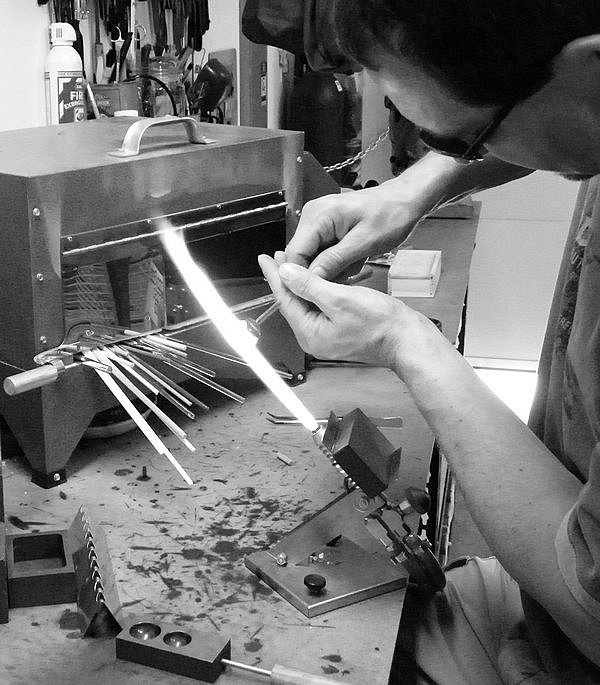
Names for Marbles
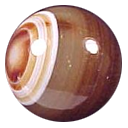
Agates or Aggies - By the middle of the nineteenth century, marbles made of agate had become so popular that the word aggie, a nickname for agate, came to be used for all stone marbles. Many were quarried and ground in Germany and then exported to America and other countries. Aggies were often colored with black, gray, green, blue and yellow mineral dyes.
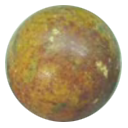
Alleys or Allies - get their name from alabaster, which is a soft stone related to marble. Alleys have come to mean very good marbles, or marbles in general.
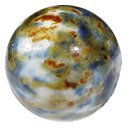
Benningtons - got their name from Bennington pottery in Vermont, which made some spotted pottery that resembled these marbles. Benningtons are blue or brown glazed marbles that aren't completely round. A Bennington has a circular unglazed spot that results from its touching another marble while still wet with glaze.
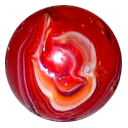
Bumboozer - a large marble or agate or glass.

Cat's Eyes - Clear marbles with different-colored blades or vanes inside. It is unusual to have black vanes inside this type of marble.

Chinas - Marbles made of china or porcelain clay. There are both glazed and unglazed chinas.
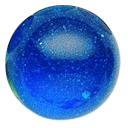
Clearies - Clear glass marbles made of a transparent single color throughout.

Clouds - End of day marbles with colored flecks of glass that aren't stretched, which look like clouds floating over the core. These marbles were individually made. They are clear glass spheres with bits of colored glass suspended within. The interior colors, blue, red, yellow, white, or end of day cloud marblegreen – are in the shape of a hot air balloon and seem to float like a cloud in the transparent marble. In come clouds, bits of colored glass were set within other colored pieces and required special skill to produce. Clouds are rare and valued by collectors.
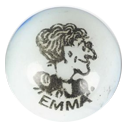
Comics or Comic Strips - Marbles with comic book characters on the surface. Only made for a brief time period, so they are rare.
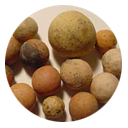
Commies - The name commies originated with a shortened form or “commoneys” because they were common, every day marbles children used for play. Originally, clay marbles were the least expensive marbles. Beginning around 1840, a factory in Ohio was producing clay marbles at a rate of 100,000 per day. Glazed or unglazed, they were colored in tans, reds, and browns of the clays they were made.
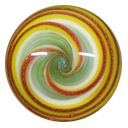
Corkscrews - Marbles with 2 or more colors in spiral designs. In corkscrews, the spirals rotate around the marble from one pole to the other, but they do not meet.

Clam broths – also known as clams, these are amongst most popular of collectible marbles. They take their name from the chowder white opaque glass from with they are made. They characteristically have many thin outer swirl lines of contrasting color running from pontil to pontil.

Crockery Marbles - Most crockery or stoneware marbles were brown with a blue glaze. They are called Benningtons because their glaze resembles that of the brown and blue glazed Bennington ware pottery produced in Bennington Vermont during the nineteenth century.
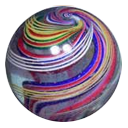
Cane-cut marbles - though some speculate that glass spheres produced near ancient Rome were used as marbles, the earliest glass toy cane cut marblemarbles were made in Germany in the middle of the nineteenth century. In 1846, a glassworker in the town of lausche invented the marbelschere, or marble scissors, a tool that rounded a marble in one step.

Colored glass coreless swirls – it was not possible to use colored glass ribbons with a colored glass marble since their interior colors wouldn't be seen, or if they were visible their colors would be muddy or unclear. As a result, colored glass marbles were coreless and were decorated with either bands or swirls of white near the surface, or color applied to the surface.
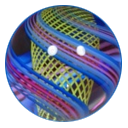
Divided core and Ribbon core – These two closely related swirls make up about 20 percent of antique swirls. Both have ribbons of color near the center which spiral from end to end.

End of day - End of day marbles were fashioned from the glass crumbs left over at the end of a workday. Traditionally, they were not sold but were modern end of day marblegiven as special treats to neighborhood children. no two end of day marbles are alike. To make an end-of-day marble, the worker gathered a small amount of glass at the end of a rod and rolled it over a powdered colored glass that served as a base color. this was heated in the furnace and then rolled again over powdered glass this time the days leftover scraps of colored glass, which adhered to the hot surface of the base color.
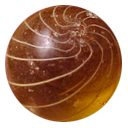
Gooseberries – gooseberries are an example of a colored glass marble. They have numerous thin white threats distributed evenly around the surface of the marble.

Glassies or puries - Clear, brightly colored glass marbles.
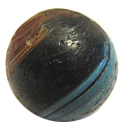
Indian Swirls – also known as indians, these opaque are made of black glass with outer bands of colored glass. They were named by authors of a marble book who mistakenly claimed that the marbles came from India.

Immies - glass marbles streaked with color so they look as if they were made of real aggate. Immie is short for immitation

Latticinio core – Takes its name from the italian word for “net” and refers to the open network of narrow strands of milky, white glass that appears in the center.

Micas - Mica was added to many kinds of marbles. green mica marblehowever, the marbles called micas are those clear or colored glass marbles with no designs in which mica flecks are suspended. The flecks of mica in the marbles add sparkle and glitter when placed in bright light. Micas are made of clear, blue, green, amber and red glass. The rare red micas are much sought after by collectors.

Milkies - opaque, milky white marbles.

Onion Skins - End of day marbles in which colored flecks of glass are stretched so that the core has may swirls, resembling an onion.

Opaque glass swirls – less translucent than colored glass swirls, opaque glass swirls are decorated with lines, bands and swirls on their surfaces.

Peewees - Small marbles, usually less than 1/2 inch wide.

Peppermint Swirls - Peppermint swirls – these popular red, white and blue swirls were made around 1876 to peppermint swirlcommemorate the American centennial. Although designs vary, each marble was fashioned from a clear core of glass surrounded by a thin layer of white glass decorated with blue bands and red stripes. The most valued peppermints are sometimes called flags.

Solid Core Lutz – Golden veins of jewel like glass sparkle vividly in these hand made swirls. Aventurine, a yellow glass containing small copper crystals give lutz marbles their phosphorescent brilliance. Lutzes are the crown jewels of marble collecting and are prized for their beauty and rarity.

Steelies - ball bearings used as marbles. Many ball bearings are used for industrial purposes.

Sulphides - Sulphides are clear glass spheres with sulphide marblewhite or silvery figures suspended in their centers – animals, birds, human figures, numbers or other figures. They were produced in Germany from the mid-nineteenth century until the end of World War One and they may have also been made in England and the United States.
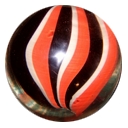
Swirls - could be handmade or machine made. The handmade ones have bands or strands running from end to end. Transparent Swirls include clear glass.
